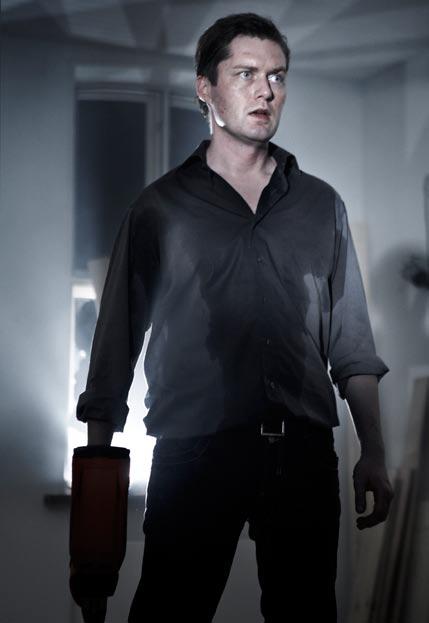"Deliver Us from Evil" can be seen as a fable peeling layer after layer off civilised people, until all that remains is a pile of raw primal urges. The film is also a Gothic tale with roots in Greek tragedy – replete with a chorus. And it has elements of political cinema, touching on such issues as class struggle, refugee policy and religious conflict. The film has a visual style marked by coolly gradated colours that makes even a sun-shiny Danish summer look bleak.
"A central location in the film is a beer tent, a place of yelling and fist-fighting, dancing and drinking - pure Sodom and Gomorrah."
“What it’s not, for sure, is a social-realist film showing West Jutland in the year 2009,” Bornedal says. “The interesting thing to me was taking somecharacters we all know and put them through some Gothic twists that distort and enhance their qualities to the point of driving them berserk. That sets the wheels in motion, churning up issues of poverty, deficiency and lack of love.”
THE BEER TENT IS A KEY LOCATION
When we first meet them, things look rosy enough for Johannes and Pernille, a nice middle-class couple moving into Johannes’ childhood home in a West Jutland village. Alain, a refugee from the Balkans, is helping them fix up the house. Then, Johannes’ younger brother Lars, a truck driver, pops up. A nice elderly lady, Anna, dies under mysterious circumstances, and Anna’s fundamentalist Lutheran husband Ingvar incites a merciless witch-hunt for the person he thinks caused his wife’s death. Steadily, the sleepy little town degenerates into a hellhole worthy of Dante’s inferno.
A central location in the film is a beer tent, a place of yelling and fist-fighting, dancing, drinking and crisscross-pissing under the long tables – pure Sodom and Gomorrah, to stay with the film’s biblical terminology. There, the lower class holds court, the proletarians that Johannes, a lawyer,dresses down in an icily condescending monologue capped with a loud “Loser!” The payback is swift and unforgiving. An angry mob in a lynching mood surrounds his house, the film’s other main location. They want Alain so they can punish him for Anna’s death.
Bornedal is obviously referencing a classic western scene here: Johannes is the sheriff defending the jailed horse thief against the angry mob outside. The sheriff represents civilisation, law and order, justice. But in Bornedal’s take on the scene, unlike a classic western, it’s a lot harder to know who to root for and who to boo.
“It’s hard to place good and evil in "Deliver Us from Evil", because it’s not so clear-cut,” he says. “In a Hollywood version, Johannes would clearly be the hero, but here he’s not. Everyone in the filmis tainted by evil. It’s like driving a stake into the ground. We have to keep driving until the stake is firmly in the ground – it can’t be halfway in, all wobbly, because that would be saying, ‘Ah, we’re not afraid to look brutality in the eye, but careful we don’t get too close ...’ That would be cheating. To be consistent, the film had to go all the way.”
EVIL ALWAYS LIES SOUTH
As the title spells out, evil is a central theme. Early on, Pernille tells her two children, “There are no evil people – only unhappy, unloved people.” Bornedal largely shares that view of the world.
“There’s always a reason why people act the way they do,” he says. “It depends on the circumstances. We’re so civilised in our part of the world, so we export evil to Sudan and the Middle East and other places in the south. For some reason, evil always lies south, while the north is associated with purity. It’s very Freudian – the mind versus the genitals – everything dangerous comes from down south. Our vocabulary has ‘us up here’ and ‘them down there.’ It’s really symbolic. It’s been part of our debate for the last 20 years and we’ve become so used to it that we don’t even think about it anymore.”
Bornedal’s film puckishly, provocatively plays around with several different vocabularies, including racist clichés and religious metaphors. The film’s religious aspects sprang from the character of Ingvar. “To create a diabolical character like Ingvar, we had to root him in something religious, in this case the fundamentalist Inner Mission sect,” Bornedal says. “I wasn’t conscious of it at the time, but I now see how it adds a political perspective. Ingvar uses religion to justify his brutal acts. Ingvar’s line: ‘The Lord gave us the word – shall we take it?’ could have been spoken by religious leaders like George W. Bush or Tony Blair. The theme encapsulates our times. And so do the racist clichés. I had fun writing those lines, because it’s fun to circle a hot-button issue without making a big deal out of it. I didn’t intend to make a political statement. The audience can make of it what they want.”
Bornedal points out that he doesn’t make a list of messages and philosophical contemplations before he starts writing a film.
“I really try to avoid dragging the analytical apparatus into the creative process,” he says. “For example, our locations came out of practical, logistical considerations. We needed a place where people get drunk, where there’d be music and an orgiastic atmosphere – so a beer tent was obvious.
“My work is based on feelings and trying to reach a point of absolute spirituality together with my crew. The method is to move into spaces and let yourself be manipulated by your characters and locations, while keeping all your senses open to the basic dramatic substance, that which induces understanding in all people. The moment you start imposing the manuscript on the process too much, and treat and talk and discuss too much, that’s when things tend to go wrong. You should try to avoid discussions and follow a musical beat and listen for a particular note. You could call it a divine note. It resonates in the body and strikes something deep within us, a core of truth and honesty. Once you hit that track, you’re on a roll. Languagelessness and intuition are great to work with.”
FILM IS A PEEPSHOW
As in several of his past films, Bornedal uses a narrator – only, "Deliver Us from Evil"’s narrator isn’t just a disembodied voice-over but an onscreen character.
“The narrator is directed like a manga character. He’s a wild young man, an androgynous type, who stands outside this universe and has nothing to do with it. He gives us the scoop, and we can make of it what we want,” Bornedal says. “He’s a fantastical character who introduces the film’s characters, saying, ‘Now we’re going this way, now this or that is happening.’ The narrator expands the film.
“Joel Grey in "Cabaret" has a similar function. Bob Fosse had an amazing talent for showing that film is a cabaret, a kind of puppet show or peepshow we look into. I was always fascinated by small children watching puppet shows. They watch two little hand puppets in a shoebox and yell, ‘Look out, Punch!’ when the Devil sneaks up on the puppet from behind. They so badly want to jump in and correct the injustice before them.“I try to translate that same intensity to film and create a situation where the audience knows all the premises and see the box. It’s a kind of Verfremdung effect – though I have a hard time with that term, because it’s so Bertolt Brecht and East German theatre.
“Nonetheless, that’s the technique I use. It’s interesting to use with media-savvy audiences who have seen thousands of films and get a million references. You can’t keep making films for hardened, calloused audiences as if they were at the movies for the first time. This film respects that."

